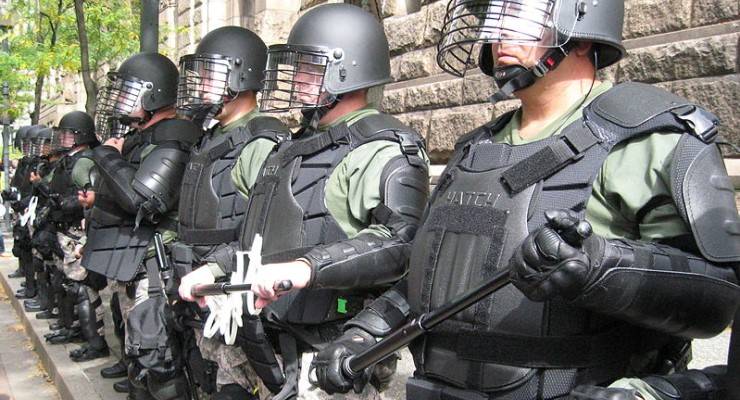
America is unravelling at speed. The societal disintegration we are watching through a million phone cameras has been centuries in the making, decades in the brewing, but less than four years in the igniting.
This is Trump’s age of “American carnage” made real. He, of course, has been hiding in the White House security bunker, emerging briefly only after his troops had tear-gassed a clear path through the peaceful protesters (and an Australian TV crew) for his triumphal shamble to a nearby church.
It is true, as many commentators say, that Australians have nothing much to feel superior about as we observe the conflagration; our own unreconciled history of racist repression and police brutality against Indigenous Australians is only favourable by relative degree against that of the United States.
It bears repeating that no Australian police officer has ever been convicted of the murder of an Aboriginal person — and not because it’s never happened.
That parallel, however, only reminds us not to be smug. There’s another lesson of more immediate import that we should take from the explosion of rage in America.
It is immediately noticeable when you view the footage that — regardless of whether it is New York, LA or Armpit Bend, Missouri — American police officers are indistinguishable from soldiers. Not just any soldiers, but special forces soldiers. Keep in mind there are more than 800,000 law enforcement officers in the US, all armed.
The militarisation of the police at all levels — local, state, federal — is almost universal and is blindingly apparent in every aspect of their approach: clothing, equipment, weaponry and, most significantly, tactics. The modern US police officer deployed for protest control duty looks like RoboCop and is armed to the literal teeth. Their vehicles are increasingly armoured and, as we’ve seen, are being used as weapons.
A brief Twitter scan this morning revealed footage of manic and unprovoked police brutality, including police vehicles driving into protesters, reporters and camera operators being beaten and shot at with rubber bullets, a black man shot dead by Louisville policemen whose body cameras were all switched off, a small child maced, national guardsmen shooting at people sitting on their front porch.
The looting is out of control, yes, but what is the role of the police? Peace officers they’re still sometimes ironically called. There to serve and protect, as the New York City police department motto still says.
Any expert in the field of policing can tell you that the only tactic that will successfully quell and resolve public violence is de-escalation.
Acknowledging that some American police officers are doing exactly that and sometimes more (such as taking a knee or even joining the march), many more appear intent on making things worse.
Some of that is white supremacy in uniform; some cops are clearly itching to bash someone’s head in. But mostly it’s the natural and inevitable consequence of a militarised policing culture.
Some years ago in New South Wales the public transport authorities started dressing their ticket inspectors (the people who can bust you for fare evasion) in quasi-military uniforms. It was fascinating to watch as they started adding more extras to their gun belts (fortunately they were never allowed actual guns) to go with combat boots, cargo pants and reflecto sunnies.
They became terrifying, and their attitude to their task began to match their trappings of state-sanctioned authority.
I don’t know why but suddenly one day that was all gone. They lost their coercive powers and were reduced to white shirts and grey pants, their only remaining weapon a digital ticket reader. Actual policing was left to the actual police. And riding a train stopped being so nerve-racking.
There are many reasons for us to be alive to these concerns. The biggest one is Home Affairs Minister Peter Dutton, whose instincts are all about policing of everything and everyone.
That his Border Force is decked out in basically fascist-looking uniforms and heavily armed is not an accident. Seen any Federal Police officers lately? Their gear is not just about self-defence. Nor is that of state police officers.
Not that a serving police officer should not wear a bullet-proof vest; part of the balance should err on the side of protecting those whose job it is to protect us. The distinctions are often subtle.
But there’s a lesson in the example set the other day by the sheriff of a suburban police department in Flint, Michigan. Wearing his vest and holstered hand gun but with no riot gear or rifle, he walked into the middle of a large angry protest crowd and asked them how he could help. They asked him to march with them in a peaceful show of anger over George Floyd’s death, and he did.
In Australia our law (thanks to Dutton) allows the federal government to send the army to respond to domestic disturbance, even if the relevant state government has not asked for assistance. The line has been blurred in a really disturbing way.
The difference between police officers and soldiers is that the former’s duty is to protect the peace and the latter’s is to shoot people until they’re dead.
Making the police look like soldiers, arming them like soldiers, and clouding the distinction between the two can have only one result: what we are seeing on our screens right now as the home of the brave tears itself apart.








It has never ceased to amaze me that cops here on the map, even in quiet country towns, have apparently never watched The Bill, seemingly preferring Hill Street Blues.
The Serco Troops in Immigration detention are also togged up for war with combat boots and paraphenalia. We have watched the militarisation of immigration centres with dismay. Along with the uniforms has come an attitude of truculence and physical force as a first resort.
ABF in their fascist black are even worse.
VicPol also in black designed to intimidate. Mick Fuller in NSW in skyblue shirt looks human and even avunculaar. Graeme Ashton in black in Vic does not. Andrews should rekit them.
You remember immediately after the World Trade Centre attacks that Bush, Howard and the gang all said this would not change us? It was bullsh!t then and it’s been bullsh!t ever since, except now it’s more visible.
But Mick Fuller is Schemo’s garbo. “Taking care” of Angus Taylor, the Ruby Princess “overflow”.
I recall Mick Fuller said on ABC radio (words to the effect) that if the people of NSW “fear” police, that’s a good thing!
Why would you hold Mr “$90K + pay rise when public servants, including front line workers, are asked to take a pay freeze” Fuller up as an example of anything reasonable or desirable?
I can’t think of the name of the relieving Commissioner who I have heard interviewed recently, but he is a massive upgrade from Fuller, and I wish he could stay!!
And at the airports. They used to wear the pale blue shirt and navy skirt/trousers. The military look came with Dutton (of course) and I don’t think Immigration staff are necessarily very comfortable with the black uniforms.
Re police and soldiers: One should have a domestic focus – protection of the community and the military should have an external focus -defending the country against external threats and the boundaries between the two should be kept.
Did you know that former Immigration Section Heads at Regional Immigration hubs, eg Bangkok Embassy which oversees Immigration sections at Australian embassies in Laos, Cambodia and Myanmar, have been called Regional Commanders since Pezzullo took over?
I think it is general across areas of the Department that wear the uniform. The airport supervisors are also called commanders or some such military-style title and many are not comfortable with this.
As you say it’s not that much different here.
Have you noticed the proliferation of various types of police lately? On top of the mob usually seen. During the plague shutdown and before that the bushfires, the district suddenly filled up with brand new copcars and some cop lookalikes marked “Crowd Response” or “Crowd Control” or somesuch.
Why do we need them? The establishment isn’t taking any chances.
Thank you for this brilliant article Michael – days like this I wish Crikey was free and widely read.
These Robo-cops are way too highly armed and unaccountable – I fear many of them are closely linked to the looney paramilitary groups, with hatred and anarchy as their tools of trade.
I wonder if the Founding Fathers had any idea where their 2nd amendment might lead?
Fairmind – with ref to your final question, I doubt it. The US can’t even see where the current troubles are going to end up, or even understand that actions have reactions.
You’d think that in a liberal democracy, having a police force restrained from engaging in excessive force would be of interests to citizens and politicians alike. These events are a reminder that the police are the way they are because democracies want the police to be this way – that there is an underclass deserving of suspicion, harassment, and even brutality in order to keep them in line. Crime and the desire for protection & retribution bring out the worst in too many people at the ballot box.